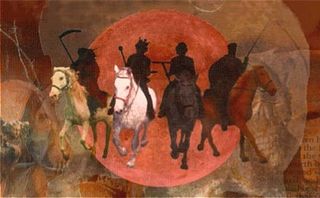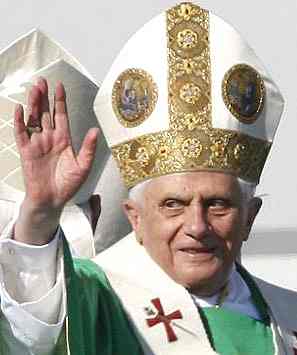 Back on November 10, well-respected Vaticanista Sandro Magister reported:
Back on November 10, well-respected Vaticanista Sandro Magister reported:
Precisely when the G20 summit in Cannes was coming to its weak and uncertain conclusion, on that same Friday, November 4 at the Vatican, a smaller summit convened in the secretariat of state was doing damage control on the latest of many moments of confusion in the Roman curia.
In the hot seat was the document on the global financial crisis released ten days earlier by the pontifical council for justice and peace. A document that had disturbed many, inside and outside of the Vatican.
The secretary of state, Cardinal Tarcisio Bertone, complained that he had not known about it until the last moment. And precisely for this reason he had called that meeting in the secretariat of state.
The conclusion of the summit was that this binding order would be transmitted to all of the offices of the curia: from that point on, nothing in writing would be released unless it had been inspected and authorized by the secretariat of state.
The PCJP document was indeed a subject of controversy. For example, some, such as the astute Mark Brumley, pointed out the difficulties that would be involved in implementing its proposals.
In anticipation of and in response to the controversy, I tried to provide some perspective to help people situate it in the overall scheme of things, including whether or not it represented an act of the Magisterium.
Magister’s piece on the document was widely hailed in the blogosphere and viewed as an indication that the document had caused a secret, closed-door Vatican smackdown.
I thought about blogging on the topic at the time, but I wanted to wait and see how the story matured.
Sandro Magister is a well-respected Vaticanista, and I always take what he has to say seriously, but it’s notoriously difficult to get accurate behind-the-scenes information on what’s going on at the Vatican, particularly in the fever swamp of Italian journalism. (N.B. ours is even worse when it comes to getting Vatican stories right!)
I wasn’t surprised, then, when John Thavis of Catholic News Service, provided a different take on the story, writing:
Then in mid-November, an Italian blogger reported that the Vatican secretary of state, Cardinal Tarcisio Bertone, had been blindsided by the text and had ordered that, from now on, all such documents must have the prior approval of his office.
Wait. Actually, I was surprised by that. “An Italian blogger?” I have great respect for bloggers (I am one), but Magister’s accomplishments go beyond merely having a WordPress account. He’s a well-respected Vaticanista. (Did I mention he’s a well-respected Vaticanista?)
And what’s with this referring to an individual public source but not giving his name? That’s just bad journalism—especially in the Internet age, when people expect not just the name of the person you’re responding to but a link directly to the piece you’re responding to. Even if Catholic News Service policy prohibits links in online stories for some foolish reason, you should at least give the name of the person you’re responding to so people can Google him, see what he said, and make up their own minds what the merits of his account versus yours are.
It’s one thing to grant anonymity to a non-public source (Magister did that, and I don’t blame Thavis for it, either), but when you’re responding to someone who has put his remarks on the public record, not giving his name is wrong.
“An Italian blogger” is wholly inadequate.
But on with the story. According to Thavis:
The real back story was far different, according to informed sources. Months ago, in view of the upcoming G-20 meeting in France Nov. 3-4, Vatican officials discussed how to make a contribution to the discussion on international monetary reform.
Three years earlier, the Vatican had been invited to a U.N.-sponsored International Conference on Financing for Development in Qatar, and the Vatican delegation had published a position paper on financial abuses. That paper was prepared by the justice and peace council, but it was presented as an official statement of the Holy See.
This year, however, because the Vatican is not a member of the G-20 and had not been invited to its meeting, Vatican officials decided that a statement on financial reform should come in the form of a “note” by the justice and peace council, rather than a formal statement of the Holy See.
The important thing was that the council’s members and consultants worked with the Secretariat of State throughout the drafting process. The “Second Section” of the Secretariat of State, which deals with foreign affairs, not only discussed the document’s approach but reviewed and “adjusted” its content before publication, sources said.
So the idea that Cardinal Peter Turkson’s justice and peace council had pulled a fast one on Vatican higher-ups was baseless. But the story got legs because of a misunderstanding that occurred about the same time.
Every year, Pope Benedict XVI—like his predecessor—issues a message for the World Day for Migrants and Refugees. The message is prepared by the pontifical council that deals with migration issues, and receives final approval by the Secretariat of State.
This year, however, extensive excerpts of the pope’s migration message were inadvertently published five days early on the website of the Vatican Information Service. The text was removed after several hours, but there was enough embarrassment to prompt action by Cardinal Bertone. He issued instructions that all documents bearing the pope’s signature must be released through the Secretariat of State, and not circulated ahead of time by other Vatican agencies.
That led some to mistakenly conclude that Cardinal Bertone was reacting to the document on financial reform, and reining in radical Roman Curia elements at the justice and peace council. On the contrary, Vatican sources said, no document on sensitive global economic issues would ever be published without the “nulla osta” of the Secretariat of State.
Thavis’s story, like Bertone’s, is based on anonymous sources, which is par for the course at the Vatican (and, these days, seemingly everywhere). It thus provides an interesting counter-portrait, though one should be aware that Thavis’s anonymous sources are not necessarily any more reliable than Magister’s. And they may both have distinct spins they want put on the basic facts.
For example, Thavis states that the idea that the PCJP had “pulled a fast one on Vatican higher-ups” was unsubstantiated. But did Magister claim that a “fast one” had been pulled?
What he said was that Bertone “complained that he had not known about it until the last moment.” That’s not saying that the PCJP was responsible for this or that it tried to pull a fast one. They may well, as Thavis states, have been in touch with the Secretariate of State all along and yet, for whatever reason, Bertone did not learn of the document until relatively late in the game—at least late enough that he wished he had known about it earlier.
So I’m not seeing Thavis’s facts and Magister’s facts as conflicting on this point.
That being said, do they conflict on others? Would Magister revise his account in any way in light of further developments?
In his latest piece, Magister writes:
With respect what www.chiesa originally reported, it should be noted that the requirement of advance review by the secretariat of state applies exclusively to texts that bear the signature of the pope, and not to those simply signed by the heads of one of the offices of the Roman curia.
The memo therefore cannot refer, strictly speaking, to the document from the pontifical council for justice and peace presented at the Vatican press office on October 24, entitled “Towards reforming the international financial and monetary systems in the context of global public authority.” A document not signed by Benedict XVI, but only by the heads of that dicastery.
It is likely, instead – as reported by the agency of the United States bishops, “Catholic News Service,” in an article on November 17 – that the memo in question was prompted by a mishap that took place with Benedict XVI’s message for the 98th World Day of Migrants and Refugees, presented at the Vatican press office on October 25.
In effect, large sections of this pontifical document had been released by the “Vatican Information Service,” the online agency of the Holy See, five days before the date set for its publication.
This does not change the fact that at the summit held at the secretariat of state on November 4, to address such incidents, there was also talk of the document on the international financial system issued autonomously by the pontifical council for justice and peace, the object of strong criticism after its publication, inside and outside of the Vatican.
From this summit came the authoritative statement from the archbishop substitute, who in the Vatican chain of command comes right after the pope and the secretary of state, Cardinal Tarcisio Bertone.
So it seems like Magister is in part modifying his original story but in part sticking with it.
He then does what so few news sources do, and for which he deserves much applause, which is to reprint the actual document he’s talking about—the memo that came out of the Secretariate of State’s meeting.
I’ve always been a believer in showing what the actual documents say, as it allows people to make up their own minds in a much more informed way than if they aren’t simply relying on somebody’s summary of an unseen text.
So be sure and check out Magister’s latest post for the text of the document.
It makes for a fascinating glimpse into inner workings of the world of Vatican documents.
What do you think?






